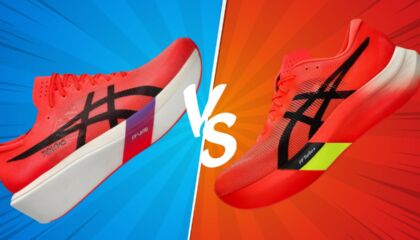


The Pegasus 36 is a versatile running shoe which has a bit of something for everyone. It can handle long runs, tempo runs and has an extremely consistent ride. The Pegasus 36 has the same midsole as the Pegasus 35 which makes the rides of the two shoes very similar.
The Pegasus 37 has a brand new midsole made from React foam which makes it softer than previous versions of the Pegasus. The Pegasus 37 also received an upper update, making it more breathable. Both shoes are priced at $120 but which of these shoes is for you?
The main difference between the Pegasus 37 and the Pegasus 36 is their midsoles. The Pegasus 36 has a traditional EVA foam midsole called Cushlon with a full-length Zoom Air unit on top of its midsole. The Pegasus 37 has Nike’s newer React foam which they call one of their “most complete” foams. The Pegasus 37 midsole is topped off with a forefoot-only Zoom Air bag.
When it comes to rides, the Pegasus 37 rides softer than the Pegasus 36 and is more responsive. The forefoot Zoom Air bag in the Pegasus 37 has a 10mm thick bag compared to the full-length 4mm thick Zoom Air unit in the Pegasus 36. This difference in thickness means that the Pegasus 37 has more “pop” on toe-off than the Pegasus 36.
The men’s version of the Pegasus 37 also has a firmer, 20 PSI Zoom Air bag compared to a softer, 15 PSI air bag in the women’s version. According to Nike, women want a softer riding shoe hence the difference in air bag densities. The men’s and women’s versions of the Pegasus 36 have the same air bag density.
The softer riding Pegasus 37 is more suited to longer, slower runs. The React foam and thick air bag are great at providing deep cushioning which doesn’t bottom out. The firmer Pegasus 36 is more suited to short, tempo runs.
Both shoes are very stable and have no lean bias but the softer midsole of the Pegasus 37 makes it slightly less stable than the Pegasus 36.
Ride transitions are smoother on the Pegasus 36 thanks to its full-length Zoom Air unit which disappears underfoot. The forefoot only Zoom Air unit can be felt in the Pegasus 37 and may feel lumpy to some runners.
The outsoles of the two shoes are very similar and grip well on all types of surfaces, wet and dry. Both shoes have a decoupling groove which separates the lateral crash rail from the rest of the outsole and a space under the centre of the heel with no rubber to make the heel more cushioned. The main difference between the two shoes is the change from pentagon-shaped lugs to waffle-shaped lugs.
The Pegasus 37 and Pegasus 36 use engineered mesh in their uppers. The difference between the two shoes is that the Pegasus 37 uses a more translucent, airy mesh which translates to a more breathable shoe.
Elf heels which flare away from the Achilles are used on both shoes which unfortunately don’t hold the heel in place very well and heel slippage occurs.
A big difference in the uppers is the use of Flywire. The Pegasus 36 uses Flywire to lock the midfoot down whereas the Pegasus 37 uses straps. The straps relieve some of the pressure on the foot.
The forefoot fit of the Pegasus 36 is more accommodating than the narrow forefoot of the Pegasus 37. The mesh of the Pegasus 37 does stretch a small amount over time to conform to the foot.
Both the Pegasus 37 and the Pegasus 36 come in narrow, regular, wide and extra wide versions.
If you’re a runner looking for a firmer, versatile shoe, get the Pegasus 36. The Pegasus 36 has smooth ride transitions due to its full-length Zoom Air bag and is a more stable shoe than the Pegasus 37.
If you want a softer shoe for long runs, get the Pegasus 37. The Pegasus 37 has a more sophisticated ride with its responsive React midsole and thick Zoom Air bag. Forefoot strikers will find the thick forefoot Zoom Air bag more engaging than the thin full-length Zoom Air bag in the Pegasus 36.
The Pegasus 37 has the more durable midsole with its React midsole as React foam doesn’t lose cushioning over time like EVA does but the Pegasus 36 has a more spacious upper than the Pegasus 37 with its narrow forefoot.